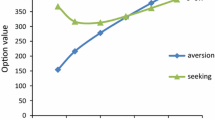Abstract
This article examines the effects of uncertainty aversion in competitive call option markets using a partial equilibrium model with the Choquet-expected utility setup. We find that the trading volume of a call option is negatively affected by uncertainty aversion, whereas the price of the call is practically independent of it.
Similar content being viewed by others
References
Carr P., Madan D. (2001), Optimal positioning in derivative securities. Quantitative Finance 1: 19–37
Chateauneuf A., Dana R.-A., Tallon J.-M. (2000), Optimal risk-sharing rules and equilibria with Choquet-expected-utility. Journal of Mathematical Economics 34: 191–214
Dekel E. (1989), Asset demand without the independence axiom.Econometrica 57: 163–169
Dow J., Werlang S.R.C. (1992), Uncertainty aversion, risk aversion, and the optimal choice of portfolio. Econometrica 60: 197–204
Duffie D. (2001), Dynamic Asset Pricing Theory. Princeton University Press, Princeton and Oxford
Epstein L.G., Wang T. (1994), Intertemporal asset pricing under Knightian uncertainty. Econometrica 62: 283–322
Ghirardato P., Marinacci M. (2002), Ambiguity made precise: A comparative foundation. Journal of Economic Theory 102: 251–289
Gilboa I. (1987), Expected utility with purely subjective non-additive probabilities. Journal of Mathematical Economics 16: 65–88
Kelsey D., Milne F. (1995), The arbitrage pricing theorem with non-expected utility preferences. Journal of Economic Theory 65: 557–574
Mas-Colell A., Whinston M.D., Green J.R. (1995), Microeconomic Theory. Oxford University Press, New York and Oxford
Montesano A., Giovannoni F. (1996), Uncertainty aversion and aversion to increasing uncertainty. Theory and Decision 41: 133–148
Montesano A. (1999) Risk and uncertainty aversion with reference to the theories of expected utility, rank dependent expected utility, and Choquet-expected utility. In: Luini L. (eds) Uncertain Decision. Bridging Theory and Experiments. Kluwer, Boston, pp 3–37
Mukerji S., Tallon J.-M. (2001), Ambiguity aversion and incompleteness of financial markets. Review of Economic Studies 68: 883–904
Shapley L.S. (1971), Cores of convex games. International Journal of Game Theory 1: 11–26
Schmeidler D. (1989), Subjective probability and expected utility without additivity. Econometrica 57: 571–587
Varian H.L. (1992), Microeconomic Analysis. W. W. Norton & Co., New York and London.
Author information
Authors and Affiliations
Corresponding author
Rights and permissions
About this article
Cite this article
Montesano, A. Effects of Uncertainty Aversion on the Call Option Market. Theory Decis 65, 97–123 (2008). https://doi.org/10.1007/s11238-007-9095-6
Received:
Accepted:
Published:
Issue Date:
DOI: https://doi.org/10.1007/s11238-007-9095-6




